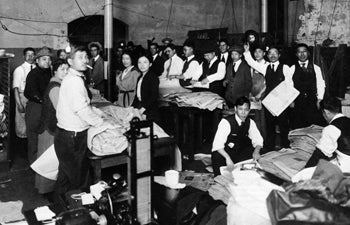Lament in the Night
The man quietly passes through the shadows, hungrily seizing a half-rotten watermelon rind from the ground at the now-deserted marketplace, later retching miserably. After checking and rechecking his coin purse for any possibility of succor, he discovers something in the deepest recesses of a neglected pocket.
Thrusting his fist into the circular light emanating from a streetlamp, he eagerly opens his fingers to discover a meager penny.
An angry curse pierces the night.
Welcome to the nocturnal world of 1920s Little Tokyo. Published in English for the first time by USC Dornsife’s Kaya Press in December 2012, Lament in the Night provides a glimpse into Los Angeles’ Little Tokyo nearly a century ago. The volume contains a novella and a full novel by Japanese immigrant author Shoson Nagahara, translated from the original Japanese by scholar Andrew Leong.
The title novella, originally published in early 1925 by a small press in Little Tokyo, follows itinerant day laborer Ishikawa Sakuzo as he wanders aimlessly through the back alleys and bathhouses of L.A., searching for food or work, but not necessarily redemption. The novel, The Tale of Osato, was serialized in the local Rafu Shimpo newspaper in the same year and follows a young, naive Japanese immigrant forced to make a living in bars and nightclubs after being abandoned by her gambling-addicted husband.

Lament in the Night is the first-ever English translation of a novel and a novella written by the long-lost Nagahara, an immigrant day laborer who came to the United States in 1918. The novel was serialized in Little Tokyo’s Rafu Shimpo newspaper in 1925. Photo by Sonali Chanchani.
As soon as Kaya Press Publisher and Editor Sunyoung Lee learned of Leong’s translation project and began reading it, she knew it was a perfect fit for Kaya.
The not-for-profit press, housed in USC Dornsife’s American studies and ethnicity department, publishes Asian and Pacific Islander diasporic literature, giving special attention to innovative, alternative narratives and the recovery of overlooked work representing the literary heritage of non-English speaking immigrants in America.
“There’s this whole lost world that people didn’t even know they were missing,” said Lee. “This is a part of American history that had been silenced because of the language barrier, yet it really changes the landscape of American literature.
“We feel we’re really filling a niche with this kind of work, which makes us very proud.”
Along with Nagahara’s writing, the book features dozens of archival photographs documenting 1920s Little Tokyo. David Ulin, Los Angeles Times book critic and lecturer in USC Dornsife’s Master of Professional Writing (MPW) program, wrote an introduction contextualizing Nagahara’s work in the literary history of L.A. and Leong wrote an intriguing afterword about the translation process.
“This is a fascinating project because much of the Asian-American writing from the 1920s through 40s was written in English and therefore intended for a broader, even mainstream audience,” said Kaya Press Media Director Neelanjana Banerjee. “So, a lot of things were glossed over. But in these stories — written in Japanese for a Japanese audience — you get the ‘secrets’ and the real stories of what was happening in the community: struggles with poverty, gambling, illicit relationships.
“It’s a whole new window into this literature.”
Though it predates noir, the writing style is decidedly similar. Nagahara paints stark yet sympathetic portraits of his characters and their struggles as immigrants in America, combining a gritty, realist sensibility with elements of traditional Japanese storytelling and epistolary techniques. Himself a young day laborer who immigrated to the U.S. in 1918, Nagahara wrote at night after long days of physical work.

This image, one of the historical photos included in Lament in the Night, shows employees of the Rafu Shimpo newspaper in 1921. The Japanese-language paper was established in Little Tokyo in 1903 and widely circulated in Southern California. Photo courtesy of Rafu Shimpo.
Nagahara was “rediscovered” by Leong during the latter’s dissertation research as a doctoral student in comparative literature at the University of California-Berkeley. He came across Nagahara’s writing serialized in the archives of the Rafu Shimpo, a widely circulated Japanese language newspaper established in L.A. in 1903 by three USC students.
“The language really captured my attention and imagination,” said Leong, now a College Fellow in English at Northwestern University. “It was a kind of Japanese that I hadn’t really read before, unveiling forgotten stories told by the people who were actually there and living them.”
“It’s a real artifact, but it’s also great fiction,” Banerjee added.
Ulin was also impressed.
“I was completely knocked out by it, both by the writing and the stories,” he said. “They are beautifully written and full of meaningful characters.”
While gathering material for his historical overview Writing Los Angeles: A Literary Anthology (Library of America, 2002), Ulin started to realize the extent to which the complex ethnic, linguistic and cultural communities of the metropolitan city made identifying a comprehensive sense of local literature difficult.
He considered the vast amount of lost or inaccessible publications and language barriers. Lament in the Night was exactly the kind of work he’d been lacking — material that has all but disappeared but that significantly broadens the scope of L.A.’s literary and cultural history.

Los Angeles Times Book Critic and Master of Professional Writing program lecturer David Ulin (left) discusses the book and translation process with translator Andrew Leong at a Feb. 23 book reading event at the Japanese American National Museum. Photo by Sonali Chanchani.
On Feb. 23, Kaya Press, in collaboration with MPW, the Huntington-USC Institute on California and the West and L.A.’s Japanese American National Museum, presented a reading event for Lament in the Night. Japanese American actors Gedde Watanabe and Tamlyn Tomita read passages from the works, followed by a lively discussion between Ulin and Leong about the book and its origins.
This publication dovetails with the Huntington-USC Institute’s focus on looking at the history of the West and passing on that research and knowledge to younger audiences. As part of their partnership, Kaya and the institute invited a group of local high school students and a youth group to attend the reading.
The partnership with MPW holds similar promise.
“As a multi-genre creative writing program, we’re interested in various forms of writing,” said Prince Gomolvilas, MPW associate director. “The art and craft of translation isn’t something that often gets explored in writing programs, so Lament in the Night is a great jumping-off point.”